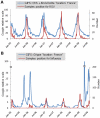Likely correlation between sources of information and acceptability of A/H1N1 swine-origin influenza virus vaccine in Marseille, France
- PMID: 20593024
- PMCID: PMC2892508
- DOI: 10.1371/journal.pone.0011292
Likely correlation between sources of information and acceptability of A/H1N1 swine-origin influenza virus vaccine in Marseille, France
Abstract
Background: In France, there was a reluctance to accept vaccination against the A/H1N1 pandemic influenza virus despite government recommendation and investment in the vaccine programme.
Methods and findings: We examined the willingness of different populations to accept A/H1N1 vaccination (i) in a French hospital among 3315 employees immunized either by in-house medical personnel or mobile teams of MDs and (ii) in a shelter housing 250 homeless persons. Google was used to assess the volume of enquiries concerning incidence of influenza. We analyzed the information on vaccination provided by Google, the website of the major French newspapers, and PubMed. Two trust Surveys were used to assess public opinion on the trustworthiness of people in different professions. Paramedics were significantly more reluctant to accept immunisation than qualified medical staff. Acceptance was significantly increased when recommended directly by MDs. Anecdotal cases of directly observed severe infections were followed by enhanced acceptance of paramedical staff. Scientific literature was significantly more in favour of vaccination than Google and French newspaper websites. In the case of the newspaper websites, information correlated with their recognised political reputations, although they would presumably claim independence from political bias. The Trust Surveys showed that politicians were highly dis-trusted in contrast with doctors and pharmacists who were considered much more trustworthy.
Conclusions: The low uptake of the vaccine could reflect failure to convey high quality medical information and advice relating to the benefits of being vaccinated. We believe that the media and internet contributed to this problem by raising concerns within the general population and that failure to involve GPs in the control programme may have been a mistake. GPs are highly regarded by the public and can provide face-to-face professional advice and information. The top-down strategy of vaccine programme management and information delivered by the Ministry of Health could have aggravated the problem, because the general population does not always trust politicians.
Conflict of interest statement
Figures






Similar articles
-
Acceptance of pandemic (H1N1) 2009 influenza vaccination by the Australian public.Med J Aust. 2010 Jan 4;192(1):33-6. doi: 10.5694/j.1326-5377.2010.tb03399.x. Med J Aust. 2010. PMID: 20047546
-
Positive attitudes of French general practitioners towards A/H1N1 influenza-pandemic vaccination: a missed opportunity to increase vaccination uptakes in the general public?Vaccine. 2010 Mar 24;28(15):2743-8. doi: 10.1016/j.vaccine.2010.01.027. Epub 2010 Jan 29. Vaccine. 2010. PMID: 20117271
-
Seasonal influenza vaccination predicts pandemic H1N1 vaccination uptake among healthcare workers in three countries.Vaccine. 2011 Oct 6;29(43):7364-9. doi: 10.1016/j.vaccine.2011.07.079. Epub 2011 Jul 30. Vaccine. 2011. PMID: 21807048
-
Why were Turks unwilling to accept the A/H1N1 influenza-pandemic vaccination? People's beliefs and perceptions about the swine flu outbreak and vaccine in the later stage of the epidemic.Vaccine. 2010 Dec 16;29(2):329-33. doi: 10.1016/j.vaccine.2010.10.030. Epub 2010 Oct 24. Vaccine. 2010. PMID: 20979988
-
Compliance with anti-H1N1 vaccine among healthcare workers and general population.Clin Microbiol Infect. 2012 Oct;18 Suppl 5:37-41. doi: 10.1111/j.1469-0691.2012.03941.x. Epub 2012 Aug 6. Clin Microbiol Infect. 2012. PMID: 22862684 Review.
Cited by
-
Provider perspectives on demand creation for maternal vaccines in Kenya.Gates Open Res. 2018 Jul 19;2:34. doi: 10.12688/gatesopenres.12833.1. Gates Open Res. 2018. PMID: 30569034 Free PMC article.
-
Improving influenza vaccination uptake among healthcare workers by on-site influenza vaccination campaign in a tertiary children hospital.Hum Vaccin Immunother. 2019;15(5):1060-1065. doi: 10.1080/21645515.2019.1575164. Epub 2019 Mar 19. Hum Vaccin Immunother. 2019. PMID: 30735439 Free PMC article.
-
Role of neighborhood social support in stress coping and psychological wellbeing during the COVID-19 pandemic: Evidence from Hubei, China.Health Place. 2021 May;69:102532. doi: 10.1016/j.healthplace.2021.102532. Epub 2021 Mar 19. Health Place. 2021. PMID: 33752161 Free PMC article.
-
Models cannot predict future outbreaks: A/H1N1 virus, the paradigm.Eur J Epidemiol. 2011 Mar;26(3):183-6. doi: 10.1007/s10654-010-9533-6. Epub 2010 Dec 14. Eur J Epidemiol. 2011. PMID: 21153911
-
Changes in psychological wellbeing, attitude and information-seeking behaviour among people at the epicentre of the COVID-19 pandemic: a panel survey of residents in Hubei province, China.Epidemiol Infect. 2020 Sep 2;148:e201. doi: 10.1017/S0950268820002009. Epidemiol Infect. 2020. PMID: 32873358 Free PMC article.
References
-
- Christenson B, Lundbergh P, Hedlund J, Ortqvist A. Effects of a large-scale intervention with influenza and 23-valent pneumococcal vaccines in adults aged 65 years or older: a prospective study. Lancet. 2001;357:1008–1011. - PubMed
-
- Nichol KL, Lind A, Margolis KL, Murdoch M, McFadden R, et al. The effectiveness of vaccination against influenza in healthy, working adults. N Engl J Med. 1995;333:889–893. - PubMed
-
- Nichol KL, Nordin JD, Nelson DB, Mullooly JP, Hak E. Effectiveness of influenza vaccine in the community-dwelling elderly. N Engl J Med. 2007;357:1373–1381. - PubMed
-
- Reichert TA, Sugaya N, Fedson DS, Glezen WP, Simonsen L, et al. The Japanese experience with vaccinating schoolchildren against influenza. N Engl J Med. 2001;344:889–896. - PubMed
Publication types
MeSH terms
Substances
LinkOut - more resources
Full Text Sources
Medical
Research Materials
Miscellaneous

